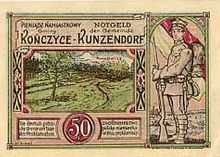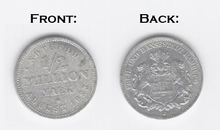Notgeld

Notgeld (German for "emergency money" or "necessity money" ; "monnaie de nécessité" in French) is the name of money issued by an institution not authorized for money emission. This occurs usually when money is not available from the central bank. The best known emergency money emissions occurred in Germany and Austria around the end of the First World War, which is why the German term is used. Issuing institutions could be e.g. town savings banks, municipalities, private and state-owned firms. It was therefore not legal tender, but rather a mutually-accepted means of payment in a particular locale or site. Notgeld is different from occupation money that is issued by an occupying army during a war.
Notgeld was mainly issued in the form of (paper) banknotes. Sometimes other forms were used, as well: coins, leather, silk, linen, stamps, aluminium foil, coal, and porcelain; there are also reports of elemental sulfur being used, as well as all sorts of re-used paper and carton material (e.g. playing cards). These pieces made from playing cards are extremely rare and are known as Spielkarten, the German word for "playing card".
Notgeld during the Great War
The first large issue of Notgeld started at the outbreak of World War I. Due to inflation—caused by the cost of the war—the value of the material that a coin was minted from was higher than the value of its denomination. Many institutions started to hoard coins. Additionally, the metals used to mint coins were needed for the production of war supplies. This caused a massive shortage of metal for coinage, which was remedied by issuing banknotes in small denominations.
As these banknotes were very colorful, they soon became a target for collectors. As the issuing bodies realized this demand, they continued to issue these notes beyond their economic necessity up till 1922. Quite often the validity period of the note had already expired when the notgeld was issued. The sets that were issued in 1920 and predominantly in 1921 were usually extremely colorful and depicted many subjects, such as local buildings, local scenes and local folklore/tales. Many series tell a short story, with often whimsical illustrations. These sets (that were not actually issued to go into circulation) were known as Serienscheine (a piece issued as a part of a series or set). As they were never issued to go into circulation, they are usually found in uncirculated condition, and are still collected by notgeld collectors all over the world.
Notgeld during the German hyperinflation

In 1922 inflation started to get out of control in Germany, leading to the German hyperinflation. Until 1923, the value of the mark deteriorated faster and faster and new money in higher denominations was issued constantly. The central bank could not cope with the logistics of providing the necessary supply of money, and Notgeld (Papiermark) was issued again—this time in denominations of thousands, millions and billions of Marks. Because the Mark became so unstable, Notgeld was also issued in the form of commodities or other currencies: wheat, rye, sugar, coal, wood, natural gas, electricity, gold, or US dollars. These pieces were known as Wertbeständige, or notes of "fixed value".
There were also notgeld coins that were made of compressed coal dust. These became quite rare, as most of them were eventually burned as fuel.
In Sweden 1715–1719
In Sweden, between 1715–1719, 42 million coins with the nominal value 1 daler silver were manufactured, but made in copper, with a much smaller metal value. All silver coins were collected by the government, which replaced them with the copper coins. They were called nödmynt ("emergency coins"). This was done to finance the Great Northern War. The government promised to exchange them into the correct value at a future time, a kind of bond made in metal. Only a small part of this value was ever paid.
External links
- Info and pictures about German notgeld
- Info about notgeld and collecting German notgeld
- German and Austrian Notgeld Banknotes
- High-resolution images of many German Notgeld Banknotes
- Information and pictures to all Austrian Notgeld periods
- Notgeld at notafilia.com.br
- Annotated Directory of German Series Notes
- Notgeld photographs on Flickr
- Belgian emergency money from the First World War: an online collection (in French)
